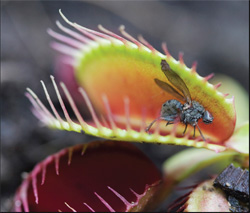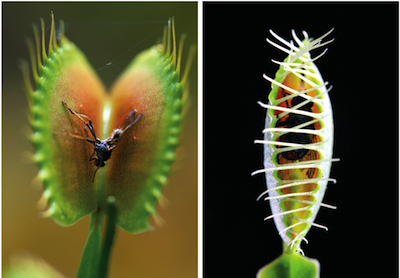
Chapter 12. Man-eating Plants
Man-eating Plants

Read the article below. Then answer the questions that follow.

In the cult classic musical The Little Shop of Horrors, two florists fall in love only to be eaten alive by a singing Venus flytrap named "Audrey II." Although real-life Venus flytraps (Dionaea muscipula) are too small to ingest humans, their jaw-like leaves snap closed faster than you can sing “please don’t eat me.”
While at rest, Venus flytrap leaves look like an open clamshell. In response to touch or movement, their hairy green “jaws” snap shut in about 100 milliseconds. Scientists say this is one of the fastest movements in the plant kingdom. But how do carnivorous plants, which have no muscles or nerve cells, respond faster than their prey, which have agile feet or even wings? Let’s take a look at what makes the Venus flytrap and other carnivorous plants capable of predatory movement.
Water ways
Plant cells consist mainly of water, and the turgor pressure exerted on their cell walls helps maintain shape and structure. Turgor pressure is tightly regulated by cell membrane machinery that controls concentration gradients across the cell membrane and thus the directional flow of water by osmosis.
This may be why Venus flytraps are convex when open, but concave when closed. One theory suggests that turgor pressure holds the jaws open. When water flows from the inner tissue towards the outer leaf, the “jaws” close around their prey.

While it is likely this motion could not happen without the flow of water inside the leaf, scientists debate whether turgor pressure alone can account for the rapidity. In other cases of plant movement, changes in turgor pressure are relatively slow. For example, the Sensitive Plant (Mimosa pudica) responds to human touch by changing the directional flow of water. However, the gradual folding of its leaves is far slower than the flytrap, which outpaces flies and spiders. Why can the Venus flytrap move more quickly?
Flytraps on film
High-speed video has shown that geometry also plays a role in the Venus flytrap’s quick response. Researchers at Harvard University used fluorescent dots to mark the external surface of the flytrap’s “jaws.” Video recordings taken under ultraviolet light traced the silhouettes of the markers before and after closure. This helped researchers estimate the spatial distribution of strain during closure.
It turns out that flytrap “jaws” change geometry, transforming from a convex to a concave shape during intermediate phases of movement. About 20% of displacement occurs in the first 1/3 of a second, while 60% of the movement occurs during an intermediate 1/10th of a second. The final 20% of the movement occurs in 1/3 of a second.
What happens during the intermediate phase? Picture holding a stretched rubber band. When you let go of the rubber band, energy is released. In a similar way, the sudden reversal of turgor pressure in the inner leaf induces the rapid, sudden snap of the jaw. In order to snap shut, the elastic energy inside the leaf has to surpass a threshold. This threshold is reached as water flows into the plant tissue, stretching long, lengthwise-oriented cells on the outer surface of the flytrap as well as cells located inside the “jaw.” These create an elastic strain much like that in a rubber band. When the stored elastic energy surpasses a threshold, the snap is quick.

What moves faster than a flytrap?
Bladderworts like Utricularia stellaris are plants that live in water or water-logged soils and digest insect larvae from the water. They do so with small bladder-like traps that line their stems. These ball-shaped bladders pull prey inside through a trapdoor. A recent study conducted at the Tata Institute in India demonstrates this rapid movement is driven by a pressure gradient.
The bladder pumps out water so that the pressure inside the bladder becomes much lower than that of the surrounding water. This causes the walls to squeeze inward giving a slightly concave appearance. When prey stimulate hair on the bladder, the trapdoor opens rapidly and water (and prey) rush inside. This happens in about 500 microseconds (μs), carrying prey inside faster than they can swim away.
The power of movement in plants
The Sensitive Plant, Venus flytrap, and bladderwort are not the only plants that move. In the late 19th century Charles Darwin studied the movement of common plants like petunias and irises. Many plants follow a discernable pattern of motion over the course of a day, although this slow movement is hardly noticeable to people. While changes in turgor pressure are involved in some instances, movement is also regulated by plant hormones.
© 2015 WH Freeman and Company.
12.1 Comprehension & Application Questions
Answer the following questions to demonstrate your understanding of the article.
1.
The Venus flytrap catches insects, digests them, and uses the digested nutrients for survival and protein synthesis. Based on that description, the Venus flytrap would be classified as a plant.
2.
Why must the trap (or "jaws") of a Venus flytrap close so quickly?
| A. |
| B. |
| C. |
| D. |
| E. |
3.
Fill in the Blank:
In plants, pressure is the pressure of the contents of the cell against the cell wall, which helps maintain shape and structure.
4.
True/False:
The movement of water into or out of cells by osmosis occurs too slowly to explain the speed at which the "jaws" of the Venus flytrap close when stimulated by prey.
5.

High-speed video taken by Harvard researchers revealed that the shape of the Venus flytrap’s “jaws” change from to when capturing prey.
6.
Which of the following is a good analogy to describe the concept of "turgor pressure"?
| A. |
| B. |
| C. |
| D. |
| E. |
7.
Consider what you know about osmosis. How might watering a potted Venus flytrap with salt water affect the functioning of its “jaws”?
| A. |
| B. |
| C. |
| D. |
| E. |
8.
The bladderwort uses a special process to capture its prey. Put the steps of this process in order by matching each step to its description. (Click to select the step number on the left, and then select the correct description on the right.)
Step 1 Step 2 Step 3 Step 4 | The bladder pumps out water, making the pressure inside the bladder lower than the pressure surrounding it. Passing prey stimulates the hair on the bladder. The trapdoor opens quickly, drawing water and the prey into the bladder. The walls of the bladder squeeze inward. |
| Correct Matches: | |
9.
How might a hole in the bladder wall of the bladderwort affect its ability to capture prey?
| A. |
| B. |
| C. |
| D. |
| E. |
10.
True/False:
Carnivorous plants like the Venus flytrap and bladderwort are the only members of the plant kingdom that exhibit movement.
Activity results are being submitted...